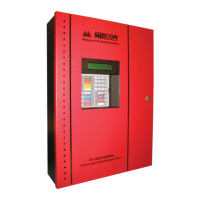30
Circuits and Devices
7.2 Analog Devices
The system supports Mircom MIX-3000 Series photo, ion, multi-sensor and thermal (heat)
type analog detectors, as well as contact input and output devices. The detectors may be
configured as non-verified or verified alarm inputs. To determine an alarm condition, the
system polls the analog device and compares the analog value against stored thresholds for
pre-alarm and alarm conditions.
A range of thresholds is provided for each type of analog device (except for contact devices),
corresponding to the agency approved range of threshold for a particular device type. Each
device can be individually configured to a value in the range of threshold for “day time” and
one for the “night time” or after hours operation; i.e. a device may be configured to a low
sensitivity for “day time” and high sensitivity at “night time”. The day time threshold will be used
unless the after hours operation is active.
7.2.1 Drift Compensation
The FX-350 will automatically adjust for gradually increasing affects of dust and other
accumulations of dirt in the detectors. It will adjust the thresholds to compensate for a detector
going dirty according to the gradual change in the normal clean air value received. When it can
no longer compensate for an increasingly dirty detector, a dirty detector trouble is indicated for
that device.
7.2.2 Auto Test
Periodically each detector is commanded to return an alarm value to test its ability to alarm. If
it fails the test, a trouble is indicated on that device.
7.3 Contact Inputs
Contact input modules on the addressable/analog device loop may be configured as any of
the following input types:
7.4 Contact Outputs
Contact output modules on the addressable/analog device loop may be configured as any of
the following output types:
• signals
• strobes
• relay outputs
Analog devices may be installed with relay or sounder bases. The outputs of these bases are
activated when the device active LED turns ON steady in response to an alarm. The command
to activate the output is separate from the command that activates the LED and they are not
subject to the same restrictions as the LED. Output
modules configured as signals are not
stroked by software at the current signal rate. When the system commands them to be either
in alert or in evacuation, the panel will simply activate them continuously. It is possible to
provide stroked operation by connecting the signal power to a conventional signal output
which is stroking at the correct rate when the device is active. Depending on the device, the
system can detect open and short troubles and report it as an output circuit trouble.
• non-verified alarm inputs • latching supervisory inputs • trouble only inputs
• waterflow inputs • monitor inputs • remote switch inputs
• non-latching supervisory inputs

